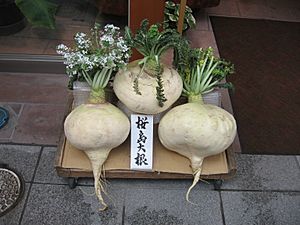Sakurajima radish facts for kids
Quick facts for kids Sakurajima radish |
|
|---|---|
 |
|
| A selection of Sakurajima radishes. | |
| Scientific classification | |
| Kingdom: | |
| (unranked): | |
| (unranked): | |
| (unranked): | |
| Order: | |
| Family: | |
| Genus: |
Raphanus
|
| Species: | |
| Trinomial name | |
| Raphanus sativus var. hortensis f. gigantissimus Makino
|
|
| Synonyms | |
|
R. acanthiformis var. gigantissimus |
|
The Sakurajima radish or Sakurajima daikon (Japanese: 桜島大根, Sakurajima daikon) is a very special type of Japanese radish. It gets its name from where it first grew, the island of Sakurajima in Japan. This island is part of Kagoshima Prefecture.
This radish is famous for being the biggest radish in the world! It usually weighs about 6 kilograms (13 pounds). But some can grow much larger, up to 27 kilograms (60 pounds). It can also be as wide as 50 centimeters (20 inches). Sometimes, people in Japan call it shimadekon, which means "island daikon."
There are three types of Sakurajima radish: early, middle, and late. The late type is the one you will most often see. Farmers plant the seeds from late August to early September. They harvest these giant radishes from December to February. To grow so big, these radishes need special care. They thrive in the volcanic ash soil found in their home region.
Contents
What Is Sakurajima Radish Called?
In English, the Sakurajima radish has a few other names. You might hear it called the Sakurajima island giant radish. People also call it the giant daikon or the jumbo daikon.
How Is Sakurajima Radish Used?
The Sakurajima radish has a smooth texture. It is not very stringy and tastes sweeter than other Japanese radishes. In Japanese cuisine, it is often cooked slowly. One popular dish is furofuki daikon, where the radish is simmered until soft.
Other popular foods made with this radish include kiriboshi daikon and tsukemono. Kiriboshi daikon is dried radish. Tsukemono are Japanese pickles. Very large tsukemono made from Sakurajima radish, called senmaizuke, are sold in souvenir shops in Kagoshima.
The History of Sakurajima Radish
Scientists have a few ideas about how this giant radish first appeared:
- It might have grown from a wild radish on Sakurajima island.
- It could have come from a radish called hōryō daikon from Aichi Prefecture.
- It might have developed from kokubu daikon (also known as hamanoichi daikon).
We know the giant Sakurajima radish was grown before 1804. That year, people mentioned it when talking about Kagoshima. At first, most of these radishes were grown northwest of Sakurajima. Later, the main growing areas moved to the north.
Many years ago, about 1,200 farms grew this radish. They had about 200 hectares (500 acres) of growing land. The Sakurajima radish was a very important crop for local farmers. During harvest season, a special market called toikae was held in Kajiki. People would trade their Sakurajima radishes for straw.
However, things changed after a big volcanic eruption in 1914. The volcano on Sakurajima caused a lot of damage. Farmers started growing satsuma oranges instead of radishes. By 1955, the growing area for Sakurajima radishes had shrunk to about 30 hectares (74 acres). By 2001, it was even smaller, only about 1.5 hectares (3.7 acres), due to ash falling from the volcano.
Today, the main places where Sakurajima radishes are grown are near Kagoshima city and Kirishima city. Because there have been fewer eruptions recently, the areas where this special radish grows have started to get bigger again.
Images for kids


